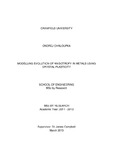JavaScript is disabled for your browser. Some features of this site may not work without it.
| dc.contributor.advisor | Campbell, James | |
| dc.contributor.author | Chaloupka, Ondrej | |
| dc.date.accessioned | 2014-05-08T13:59:34Z | |
| dc.date.available | 2014-05-08T13:59:34Z | |
| dc.date.issued | 2013-03 | |
| dc.identifier.uri | http://dspace.lib.cranfield.ac.uk/handle/1826/8435 | |
| dc.description.abstract | Many metals used in modern engineering exhibit anisotropy. A common assumption when modelling anisotropic metals is that the level of anisotropy is fixed throughout the calculation. As it is well understood that processes such as cold rolling, forging or shock loading change the level of anisotropy, it is clear that this assumption is not accurate when dealing with large deformations. The aim of this project was to develop a tool capable to predict large deformations of a single crystal or crystalline aggregate of a metal of interest and able to trace an evolution of anisotropy within the material. The outcome of this project is a verified computational tool capable of predicting large deformations in metals. This computational tool is built on the Crystal Plasticity Finite Element Method (CPFEM). The CPFEM in this project is an implementation of an existing constitutive model, based on the crystal plasticity theory (the single crystal strength model), into the framework of the FEA software DYNA3D® . Accuracy of the new tool was validated for a large deformation of a single crystal of an annealed OFHC copper at room temperature. The implementation was also tested for a large deformation of a polycrystalline aggregate comprised of 512 crystals of an annealed anisotropic OFHC copper in a uniaxial compression and tension test. Here sufficient agreement with the experimental data was not achieved and further investigation was proposed in order to find out the cause of the discrepancy. Moreover, the behaviour of anisotropic metals during a large deformation was modelled and it was demonstrated that this tool is able to trace the evolution of anisotropy. The main benefit of having this computational tool lies in virtual material testing. This testing has the advantage over experiments in time and cost expenses. This tool and its future improvements, which were proposed, will allow studying evolution of anisotropy in FCC and BCC materials during dynamic finite deformations, which can lead to current material models improvement. | en_UK |
| dc.language.iso | en | en_UK |
| dc.publisher | Cranfield University | en_UK |
| dc.rights | © Cranfield University 2013. All rights reserved. No part of this publication may be reproduced without the written permission of the copyright owner. | en_UK |
| dc.subject | CPFEM | en_UK |
| dc.subject | Dislocation slip | en_UK |
| dc.subject | FCC system | en_UK |
| dc.subject | Explicit FEA | en_UK |
| dc.subject | Elastic plastic deformation | en_UK |
| dc.title | Modelling evolution of anisotropy in metals using crystal plasticity | en_UK |
| dc.type | Thesis or dissertation | en_UK |
| dc.type.qualificationlevel | Masters | en_UK |
| dc.type.qualificationname | MSc by Research | en_UK |
